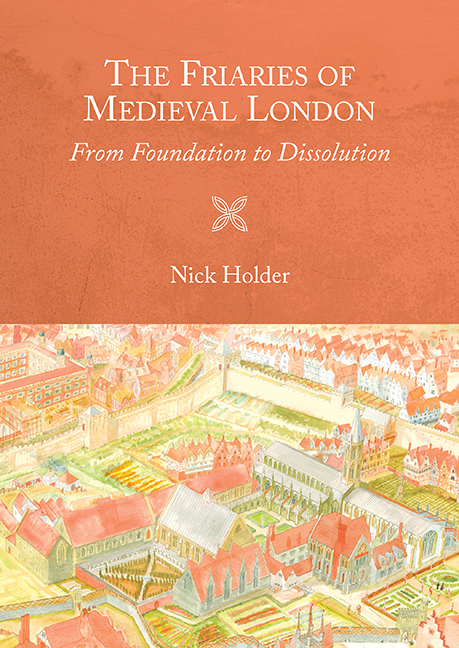Book contents
- Frontmatter
- Contents
- List of Illustrations and Tables
- Contributors
- Acknowledgements
- Abbreviations
- Introduction
- Part I The Nine London Friaries
- 1 The First Black Friars in Holborn, c. 1223–86
- 2 The Second Black Friars, 1275–1538
- 3 The Third Black Friars at St Bartholomew's, 1556–9
- 4 Grey Friars, 1225–1538
- 5 White Friars, c. 1247–1538
- 6 Austin Friars, c. 1265–1538
- 7 Crossed Friars, c. 1268–1538
- 8 Sack Friars, c. 1270–1305
- 9 Pied Friars, 1267–1317
- Part II The London Friars and their Friaries
- Conclusions
- Timeline
- Bibliography
- Index
- Miscellaneous Endmatter
9 - Pied Friars, 1267–1317
from Part I - The Nine London Friaries
Published online by Cambridge University Press: 16 May 2018
- Frontmatter
- Contents
- List of Illustrations and Tables
- Contributors
- Acknowledgements
- Abbreviations
- Introduction
- Part I The Nine London Friaries
- 1 The First Black Friars in Holborn, c. 1223–86
- 2 The Second Black Friars, 1275–1538
- 3 The Third Black Friars at St Bartholomew's, 1556–9
- 4 Grey Friars, 1225–1538
- 5 White Friars, c. 1247–1538
- 6 Austin Friars, c. 1265–1538
- 7 Crossed Friars, c. 1268–1538
- 8 Sack Friars, c. 1270–1305
- 9 Pied Friars, 1267–1317
- Part II The London Friars and their Friaries
- Conclusions
- Timeline
- Bibliography
- Index
- Miscellaneous Endmatter
Summary
THE final London friary to consider is that of the Friars of the Blessed Mary (fratres beate Marie), also known as the Pied friars. The order began in Marseilles in the mid thirteenth century and the bishop soon granted them a chapel in the area of the city known as Aren in 1259, thus giving the order one of their (many) Latin names of fratres de Areno. These friars were the least successful of the thirteenth-century mendicant orders, ending up with about seven houses in France and another half dozen elsewhere in Europe. They arrived in England in 1267 where they became known as the Pied friars (fratres de pica), a playful reference to their magpie-like appearance with a black outer scapular over their white mantle. After founding their first English house in London, they had established a second house in Norwich by 1274. The London friary housed about twenty friars in the 1270s and ‘80s: the order was clearly quite successful in its early days in England. However, like the Sack friars, the Pied friars were in effect killed off at the Second Council of Lyon in 1274, which prevented the lesser mendicant orders from recruiting new members. The number of friars, unsurprisingly, declined, with twelve living at the London friary in 1297 and a sole survivor, Hugh of York, collecting his royal alms in April 1317.
The main source for the London house is an order recorded on the Close rolls and resulting from an inquisition into the former house after the death of Hugh in August 1317. The royal order – which recounts the history of the house – returned the property to the original owners, Westminster Abbey, and it became part of the abbey estate that supported the sacrist; the sacrist's accounts and leases therefore contain a number of useful references to the former friary. No archaeological work has been carried out within the area of the friary, which lies between Covent Garden and the Strand (Figure 61).
The friary
Henry III granted the newly arrived Pied friars the right to establish an English friary in October 1267.
- Type
- Chapter
- Information
- The Friaries of Medieval LondonFrom Foundation to Dissolution, pp. 167 - 172Publisher: Boydell & BrewerPrint publication year: 2017



